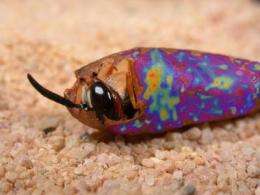Beewolves protect their offspring with antibiotics

Digger wasps of the genus Philanthus, so-called beewolves, house beneficial bacteria on their cocoons that guarantee protection against harmful microorganisms. Scientists of the Max Planck Institute for Chemical Ecology in Jena teamed up with researchers at the University of Regensburg and the Jena Leibniz Institute for Natural Product Research - Hans-Knoell-Institute - and discovered that bacteria of the genus Streptomyces produce a cocktail of nine different antibiotics and thereby fend off invading pathogens.
Using imaging techniques based on mass spectrometry, the antibiotics could be displayed in vivo on the cocoon's exterior surface. Moreover, it was shown that the use of different kinds of antibiotics provides an effective protection against infection with a multitude of different pathogenic microorganisms. Thus, for millions of years beewolves have been taking advantage of a principle that is known as combination prophylaxis in human medicine. (Nature Chemical Biology, Advance Online Publication, February 28, 2010)
Many insects spend a part of their life underground and are exposed to the risk of fungal or bacterial infections. This is also the case for many digger wasp species that construct underground nests. Unlike bees that use pollen and nectar as food to nurture their larvae, digger wasps hunt insects to feed their offspring. Because of the warm and humid conditions as well as the large amounts of organic material in their subterranean nest, both their food supply and their larvae are endangered by pathogens - mold and bacterial infection are a major threat and can cause larval death in many cases.
Symbiosis with bacteria increases survival rate of beewolf larvae
Beewolves, i.e. digger wasps that hunt for bees to feed their larvae, have evolved an elegant solution to the problem of fungal and bacterial infection. Martin Kaltenpoth and colleagues from the University of Wurzburg had already shown several years ago that beewolves form a symbiotic relationship with bacteria of the genus Streptomyces. Female beewolves cultivate these bacteria in specialized antennal gland reservoirs and apply them to the ceiling of the brood cells. Beewolf larvae later take up the bacteria and transfer the symbionts actively to their cocoons, thereby increasing their survival probability. However, it has been unclear so far how the protection is achieved.
Scientists of the groups of Aleš Svatoš and Martin Kaltenpoth at the Max Planck Institute in cooperation with their colleagues at the University of Regensburg and the Hans-Knoell-Institute in Jena now discovered that the symbionts produce nine different antibiotic substances. For the first time the biologists were able to identify these substances directly in the natural environment, i.e. on the beewolf cocoon (see figure). Other studies on protective symbioses could detect antibiotic substances only after isolation and cultivation of the symbionts in artificial culture media. By means of a novel technique of imaging mass spectrometry (LDI imaging), the Jena scientists could demonstrate that the antibiotics are primarily present on the exterior of the cocoon, reducing the risk of potentially harmful side-effects on the larvae.
"Combination Medication" broadens the spectrum of efficacy
In biotests with different pathogenic fungi and bacteria the scientists observed that beewolves utilize the principle of combination medication: "A combined treatment with streptochlorin and eight different piericidines we were able to isolate from the cocoon helps to fend off a very broad spectrum of microorganisms; this cannot be achieved with a single substance. This means that millions of years ago, beewolves and their symbionts have already evolved a strategy that is known from human medicine as combination prophylaxis" explains Johannes Kroiss, first author of the study.
With their work the researchers break new ground: "Astonishingly, little is known about the ecological importance of antibiotics in their natural environment. Supported by mass spectrometric imaging we are now able to better understand the natural role of antibiotic substances in the environment," says Aleš Svatoš, leader of the mass spectrometry research group. The imaging techniques can help to provide important insights, especially into the exploration of symbiotic interactions. "We suppose that protective symbioses like the ones between beewolves and Streptomyces bacteria are much more common in the animal kingdom than previously assumed," says Martin Kaltenpoth, who heads a Max Planck Research Group on Insect-Bacteria Symbiosis since January. "An analysis of the substances involved not only contributes to the understanding of the evolution of such symbioses but could also lead to the discovery of interesting new drug candidates for human medicine."
More information: Johannes Kroiss, Martin Kaltenpoth, Bernd Schneider, Maria-Gabriele Schwinger, Christian Hertweck, Ravi Kumar Maddula, Erhard Strohm, Aleš Svatoš: Symbiotic streptomycetes provide antibiotic combination prophylaxis for wasp offspring. Nature Chemical Biology, Advance online publication, February 28, 2010, DOI 10.1038/nchembio.331
Provided by Max Planck Institute for Chemical Ecology
















